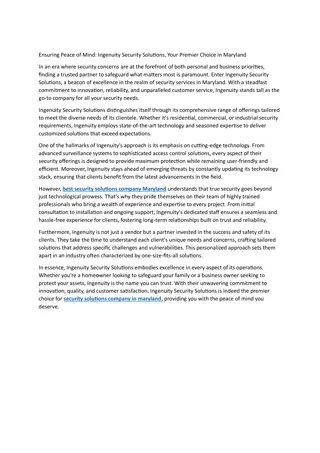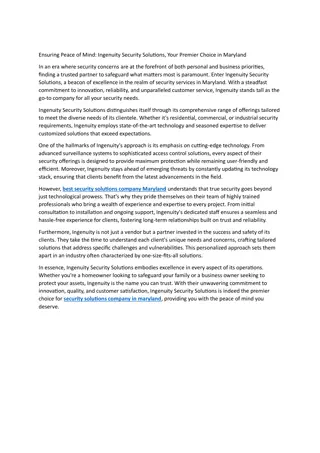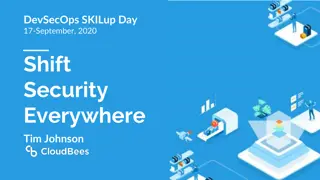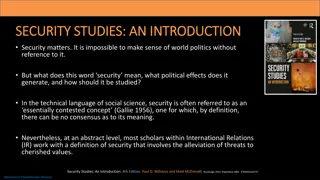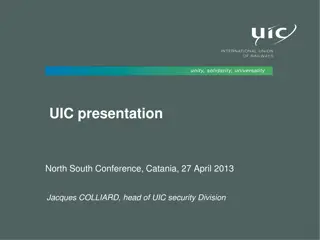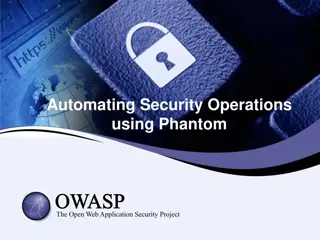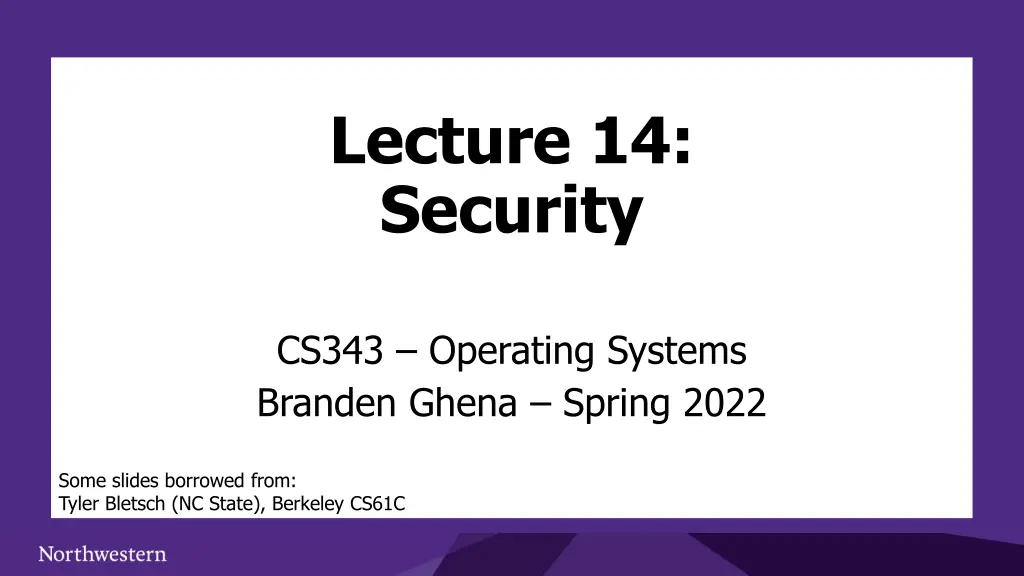
Understanding Computer Security in Operating Systems
Explore the importance of computer security, the evolution of security considerations in early computers, the impact of connectivity on security concerns, and the threat of botnets like Mirai in the digital age. Learn about memory-based attacks, speculative execution vulnerabilities, and the implications of interconnected systems in today's digital landscape.
Download Presentation

Please find below an Image/Link to download the presentation.
The content on the website is provided AS IS for your information and personal use only. It may not be sold, licensed, or shared on other websites without obtaining consent from the author. If you encounter any issues during the download, it is possible that the publisher has removed the file from their server.
You are allowed to download the files provided on this website for personal or commercial use, subject to the condition that they are used lawfully. All files are the property of their respective owners.
The content on the website is provided AS IS for your information and personal use only. It may not be sold, licensed, or shared on other websites without obtaining consent from the author.
E N D
Presentation Transcript
Lecture 14: Security CS343 Operating Systems Branden Ghena Spring 2022 Some slides borrowed from: Tyler Bletsch (NC State), Berkeley CS61C
Todays Goals Introduce OS security considerations. Describe memory-based attacks and defenses. Explore speculative execution attacks and ramifications. 2
Why is computer security so important? Most public security happens at least in some portion on the honor system Pretty easy to break a window Keyed locks are easy to pick Master keys can be determined and manufactured (Matt Blaze attack) Laws apply after you ve done it 3
Early computers didnt have any security either Simple machines for doing computation do not have private files or contention Timeslicing machines meant there were multiple users, but all were employees of the same company Permissions needed to be as secure as a file in a locked drawer on a desk The act of breaking into a computer system has to have the same social stigma as breaking into a neighbor's house. It should not matter that the neighbor's door is unlocked. - Ken Thompson, Turing Award Lecture, 1984 4
Connectivity of computers makes security a top concern Importantly, physical item security is dependent on the fact that one person can only steal one thing at a time And it s usually obvious when theft occurs The internet changed all of this for computers Usually not people breaking into computers manually, one at a time Instead it is computers breaking into computers by means of scripting And you can access a computer from anywhere on Earth Breaking into or controlling one car is a crime Controlling 100,000 cars remotely is a problem for the manufacturer 5
Mirai botnet (2016) Takes control of up to 600,000 insecure connected devices IP-attached cameras, DVRs, routers, printers 6
Botnets can be directed towards denial-of-service attacks Mirai is used for DDOS attacks on various websites Krebs on Security blog gets 623 Gbps of traffic during one attack DDOS attacks targeting Krebs on Security 7
Outline Design for security Memory attacks and defenses Buffer overflow and No-Execute bit Return-Oriented Programming and Address Space Layout Randomization Speculative execution attacks Meltdown Spectre 8
Trusted Computing Base (TCB) Trusted Computing Base is everything the OS relies on to enforce security If everything outside of the TCB is evil , the TCB can still be trusted Important to be a clear, minimum set of components TCB includes Scheduler, Memory Management, Parts of file system, Parts of device drivers Anything else must be assumed malicious Processes memory accesses, System call arguments, Received packets 9
Modern code bases are enormous For many projects, no one person has read and understood all of it Program/Use Case Millions of Lines of Code 0.01 0.04 0.4 2.5 5 9.7 24 25 40 62 68 Unix v1.0 Average iPhone app Space Shuttle Windows 3.1 Mars Curiosity Rover Firefox (2015) F-35 Fighter jet Microsoft Office 2001 Windows 7 Facebook (2015) Debian 5.0 codebase TCB needs to be agreed upon by everyone working on the project And needs to enforced by everyone in the project https://www.informationisbeautiful.net/ visualizations/million-lines-of-code/ 10
Writing auditable code Code style and semantics really do matter!! If you want code to be secure, it needs to be read AND understood by many people Bad code style/semantics builds up cognitive load of the reader making them less likely to notice when something is wrong 0 versus NULL &buf[0] versus &(buf[0]) int x, y, z; versus int x; int y; int z; 11
Apple goto fail SSL bug Spacing intentional. This code mixes tabs and spaces and has random extra line breaks. ... if ((err = SSLFreeBuffer(&hashCtx)) != 0) goto fail; It is actually decently commented, just not in this particular section. if ((err = ReadyHash(&SSLHashSHA1, &hashCtx)) != 0) goto fail; if ((err = SSLHashSHA1.update(&hashCtx, &clientRandom)) != 0) goto fail; if ((err = SSLHashSHA1.update(&hashCtx, &serverRandom)) != 0) goto fail; if ((err = SSLHashSHA1.update(&hashCtx, &signedParams)) != 0) goto fail; goto fail; if ((err = SSLHashSHA1.final(&hashCtx, &hashOut)) != 0) goto fail; ... 12
Apple goto fail SSL bug Spacing intentional. This code mixes tabs and spaces and has random extra line breaks. ... if ((err = SSLFreeBuffer(&hashCtx)) != 0) goto fail; It is actually decently commented, just not in this particular section. if ((err = ReadyHash(&SSLHashSHA1, &hashCtx)) != 0) goto fail; if ((err = SSLHashSHA1.update(&hashCtx, &clientRandom)) != 0) goto fail; if ((err = SSLHashSHA1.update(&hashCtx, &serverRandom)) != 0) goto fail; if ((err = SSLHashSHA1.update(&hashCtx, &signedParams)) != 0) goto fail; goto fail; if ((err = SSLHashSHA1.final(&hashCtx, &hashOut)) != 0) goto fail; ... 13
Apple goto fail SSL bug Spacing intentional. This code mixes tabs and spaces and has random extra line breaks. ... if ((err = SSLFreeBuffer(&hashCtx)) != 0) goto fail; It is actually decently commented, just not in this particular section. if ((err = ReadyHash(&SSLHashSHA1, &hashCtx)) != 0) goto fail; if ((err = SSLHashSHA1.update(&hashCtx, &clientRandom)) != 0) goto fail; if ((err = SSLHashSHA1.update(&hashCtx, &serverRandom)) != 0) goto fail; if ((err = SSLHashSHA1.update(&hashCtx, &signedParams)) != 0) goto fail; goto fail; if ((err = SSLHashSHA1.final(&hashCtx, &hashOut)) != 0) goto fail; ... Outside of IF statement!! Always runs. 14
Security properties OS should enforce Confidentiality Private information should remain private Example: processes can t read memory in another process Integrity Mechanisms should not be modified without permission Example: OS data structures can t be modified by processes Availability Resources on the computer should be able to be fairly accessed Example: network access is shared among processes 15
OS security concerns Processor access Integrity: User versus kernel mode Availability: Timeslicing Memory access Confidentiality and Integrity: Virtual memory (and permissions) Availability: Swapping File access Confidentiality: Permissions (user and group) Integrity: only accessible through system calls 16
What about devices? Device access Confidentiality: User permissions sort of? This gets complicated Should any app I run be able to activate my webcam or microphone? When should Uber be able to access my location? Still figuring this one out Smartphones are at the forefront 17
Security is an arms race There is no single fix for system security New attacks are constantly being discovered New solutions are constantly being applied 1. Find a vulnerability and how it can be exploited 2. Fix vulnerability 3. Go back to 1 But if the OS is designed with security in mind, it s hopefully harder to find vulnerabilities in the first place 18
Break + xkcd https://xkcd.com/538/ 19
Outline Design for security Memory attacks and defenses Buffer overflow and No-Execute bit Return-Oriented Programming and Address Space Layout Randomization Speculative execution attacks Meltdown Spectre 20
Whats wrong with this code? #include <stdlib.h> #include <stdio.h> int main() { char name[1024]; printf("What is your name? "); scanf("%s", name); printf("%s is cool.\n", name); return 0; } 21
Buffer Overflow Arrays (buffers) in C are not bounds checked Can keep writing past the end of the array Overwrites either data section or stack section Still an incredibly common problem in C Key problem Trusting input from an untrustworthy source Users are not part of the trusted computing base Certainly not arbitrary inputs they can make 24
Heartbleed attack Vulnerability in OpenSSL 2014 Started the trend of vulnerabilities with cool names and logos 25
Unsafe C library functions (and replacements) Better choices: char *fgets(char *s, int size, FILE *stream) snprintf(char *str, size_t size, const char *format, ...); strncat(char *dest, const char *src, size_t n) strncpy(char *dest, const char *src, size_t n) vsnprintf(char *str, size_t size, const char *format, va_list ap) 26
Buffer overflows can overwrite important variables Long input string can overwrite variables on the stack Such as the password check int main(int argc, char *argv[]) { char passwd_ok = 0; char passwd[8]; strcpy(passwd, argv[1]); if (strcmp(passwd, "niklas")==0) passwd_ok = 1; if (passwd_ok) { ... } } longpassword1 27
Buffer overflows can overwrite function pointers Overwriting a function pointer can allow you to redirect code anywhere char buffer[100]; void (*func)(char*) = thisfunc; strcpy(buffer, argv[1]); func(buffer); First writing machine code in the stack then overwriting function pointer to execute it allows for arbitrary code execution arbitrarycodeX 28
Return addresses constantly live on the stack Recall: When a function is called parameters are pushed on stack return address pushed on stack called function puts local variables on the stack Memory layout arbitrarystuffX C s calling convention means arbitrary execution could happen anywhere! 29
What do you do with arbitrary execution? Open a shell that can run anything Top: C code Middle: position-independent x86 assembly Bottom: machine code hex 30
Morris Worm November 02, 1988 Roughly 88,000 computers on internet at the time Worm Invading program that installs itself on additional computers Infected several thousand computers, taking down internet for several days 31
How the worm entered computers 1. Debug vulnerability in sendmail - email sending service Connect, enter debug mode, send arbitrary code to execute 2. Buffer overflow in finger lists users on server Send request with more than 512 bytes of arguments Execute /bin/sh 3. Guess passwords Get list of users for the machine worm is already running in Guess username, reverse username, 400 popular words, entire dictionary 32
Effects of Morris Worm Morris Worm created too many copies of itself Checked if there was already a worm on the computer before running 1/7 of the executables ran anyways (too high a default) Computers ended up with many processes running Check your understanding: How are too many processes harmful? 33
Effects of Morris Worm Morris Worm created too many copies of itself Checked if there was already a worm on the computer before running 1/7 of the executables ran anyways (too high a default) Computers ended up with many processes running Long response time due to so many processes Thrashing due to too much memory pressure Slowed computers to a halt Outcomes: Invaded ~6000 computers in hours (10% of the Internet at the time) CERT was created to manage software security First Computer Fraud and Abuse Act (CFAA) prosecution 34
Disable execution in the stack The OS can allow a region to be written or executed But not both! NX bit in x86-64 (no-execute) 35
Overcoming no-execute Do we need malicious code to have malicious behavior? No argument 2 argument 1 argument 2 argument 1 argument 2 argument 1 "/bin/sh" Address of attack code Address of system() RA RA RA frame pointer locals frame pointer locals frame pointer locals Padding Attack code (launch a shell) buffer buffer buffer Code reuse (!) Default Stack Code injection "Return-into-libc" attack 36
Return-oriented programming More general process to enable arbitrary execution without code rewrite Look through assembly instructions followed by a return Known as gadgets Chain these gadget together to make working code By placing addresses on stack 37
Gadgets can create a Turing-complete programming environment Loading constants Control flow pop eax ; ret pop esp ; ret ... 0x55555555 stack pointer stack pointer Memory Arithmetic pop eax ; ret add eax, ebx ; ret mov ebx, [eax] ; ret 0x8070abcd (address) stack pointer 38 stack pointer
Address-space layout randomization (ASLR) Randomize memory region locations in virtual memory Already spread throughout physical memory Move locations of libraries and code relative to each other Arbitrary address for attacker to send code to gets harder to predict! Implemented 2005-2007 Linux, MacOS, and Windows 2011 for Android and iOS Running a process again re-randomizes its layout 39
Overcoming ASLR ASLR is a probabilistic approach, merely increases attacker s expected work Each failed attempt results in crash; at restart, randomization is different Counters: Information leakage Program reveals a pointer? Game over. De-randomization attack Just keep trying! (carefully) 32-bit ASLR defeated in 216 seconds Under certain scenarios is less effective Poor source of randomness 40
Break + Question The Common Vulnerabilities and Exposures (CVE) system documents publicly released software vulnerabilities. How long has it been since the last CVE due to a buffer overflow? https://www.cvedetails.com/vulnerability-list.php 41
Break + Question The Common Vulnerabilities and Exposures (CVE) system documents publicly released software vulnerabilities. How long has it been since the last CVE due to a buffer overflow? Today is Thursday (5/19) Wednesday (5/18) Tuesday (5/17) Monday (5/16) https://www.cvedetails.com/vulnerability-list.php 42
Outline Design for security Memory attacks and defenses Buffer overflow and No-Execute bit Return-Oriented Programming and Address Space Layout Randomization Speculative execution attacks Meltdown Spectre 43
Background: Side channel attacks Important for understanding speculative execution attacks Many physical systems have properties that may leak information about internal state Determine RSA key bits based on power use during a decrypt operation Determine length of password by how long it takes to check it 44
Timing attacks are one side channel Timing attacks can be overcome with constant-time algorithms which always take as long as the worst-case execution time But this means reducing performance Caches are essentially one big timing attack Speeds up access to data if it is present in the cache This was the goal!! An attack can know which data was accessed recently 45
Background: Speculative Execution Modern processors want to always be doing something What if we re going to branch based on a memory load? What if we just guess what the result will be and start executing early!! So they are often speculatively executing instructions Perform the operation and throw out the result if we shouldn t actually do it For example, branch prediction 46
Optimization: Kernel Mapped in Virtual Memory Virtual Memory Page tables map virtual memory to physical memory for a process 0xFFFFFFFF Process Memory But actually, we often leave the OS memory in the page table too Each page is marked as no-read, no-write Faster to switch back to the OS No need to TLB flush or page table swap if the OS intends to go right back to process Empty OS Memory Empty 0x00000000 47
Meltdown Security vulnerability in all modern processors that allows arbitrary reads from memory Disclosed in January 2018 by: Jann Horn (Google Project Zero), Werner Haas, Thomas Prescher (Cyberus Technology), Daniel Gruss, Moritz Lipp, Stefan Mangard, Michael Schwarz (Graz University of Technology) Details: https://hackernoon.com/a-simplified-explanation-of-the-meltdown-cpu-vulnerability-ad316cd0f0de https://meltdownattack.com/meltdown.pdf 48
Step 1: Read from a kernel address mov $KERNEL_ADDRESS_OF_SECRET, %r12 mov (%r12), %eax %eaxnow holds a byte of memory that we shouldn t able to access This will be an invalid page fault! Once the instruction actually hits the end of the pipeline... For now, it loads that value into %r12 right away and continues executing speculatively 49
Step 2: Read based on secret mov $KERNEL_ADDRESS_OF_SECRET, %r12 mov (%r12), %eax mov MY_ARRAY(%eax), %edx %edx is a valid read from our own memory This is never going to finish either because the process will have an exception from the prior instruction, but it will start executing... 50










